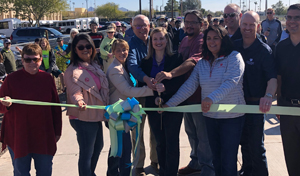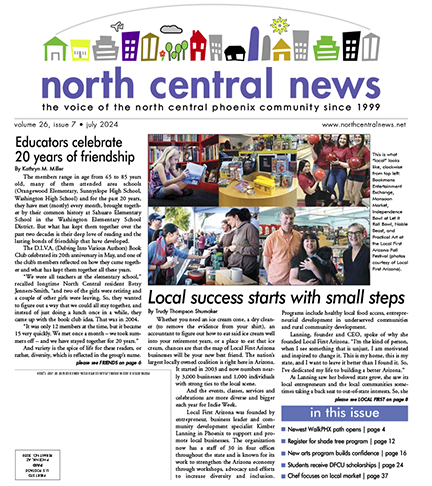Phoenix’s Grand Canal is a modern recreation destination after undergoing a major transformation.
City officials held a ribbon-cutting ceremony on Feb. 15 near Central Avenue to officially open the Grand Canalscape, a 12-mile continuous trail along the canal. Improvements included a paved multi-use trail, pedestrian bridges, and traffic signals with crosswalks at key intersections.
The festivities stretched over a one-mile portion of the trail from Ninth Avenue to Seventh Street between Camelback and Indian School roads. Participants could visit more than three dozen booths that offered games, face painting and free food and water.
Phoenix Mayor Kate Gallego spoke before a small crowd at the celebration about the history of the canal system and how crucial it is to the booming metropolis Phoenix has become.
“The city of Phoenix would not exist without the canals,” Gallego said. “They’re our past and they deserve to be our future.”
Phoenix City Councilmember Laura Pastor, who represents District 4, through which most of the canal runs, was one of a handful of city officials who attended the celebration.
Growing up in the district she now represents, Pastor said she wants the canal to unite the Valley, especially in this current age of technology.
“To me that’s what’s important, is to see and greet one another, especially in this day and age of internet, phones and games,” Pastor said.
To enable this, 17 improved neighborhood access connections have been added to allow people greater access to medical, educational and employment centers, as well as bus and light rail lines. The trail is Americans with Disabilities Act (ADA)-accessible with paved walkways on both sides of the canal.
Pastor also recognizes the dangers for pedestrians with a majority of pedestrian deaths occurring in her district, which includes central Phoenix around I-17 and north of the I-10.
This is why it was paramount to add 13 new crosswalk signals where the trail crosses roadways to make it safer for pedestrians to walk.
Much of the funding came from the U.S. Department of Transportation’s $10.3 million Transportation Investment Generating Economic Recovery (TIGER) Grant.
Along with another $10 million from Salt River Project’s aesthetic funds, only about $2 million or 9-percent of the project was paid for by local funds.
Currently more than 80 miles of multi-use trails have been developed along canal banks throughout the Valley, according to a press release.
SRP has allowed licensed recreational use of the canal banks since 1964.
The Grand Canal was developed in the 1870s to bring water from the Salt and Verde rivers to the Salt River Valley and is the oldest remaining pioneer canal in the Valley north of the Salt River.










































